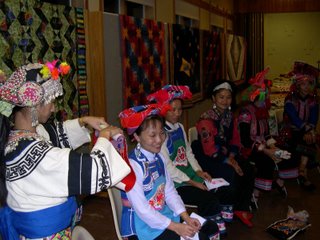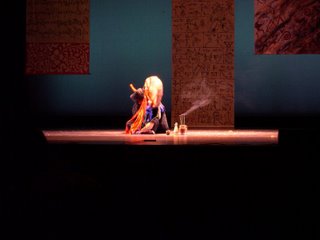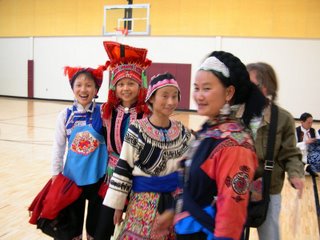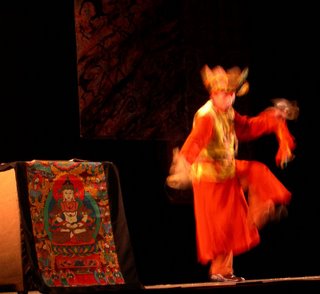
For those of you who missed it, Yunnan Revealed is a tour of the US that we did last year.
I'll start with Yunnan so you can better understand what we were revealing. Yunnan is China's southwesternmost province, and it borders Tibet, Burma, Laos and Vietnam. With an altitude ranging from 50 meters to 6,000 meters, it is China's most biologically and culturally diverse province and in my opinion one of the coolest places on earth.
 It is home to more than half of continental Asia's plant and animal species and twenty six ethnic groups that posess their own distinct languages, histories and cultures.
It is home to more than half of continental Asia's plant and animal species and twenty six ethnic groups that posess their own distinct languages, histories and cultures.Yunnan Revealed was a joint effort between Connecticut College, Flynn Theatre, Dartmouth University, China Yunnan International Cultural Exchange Center and Yuansheng Indigenous Music and Dance Studio. It brought fifteen traditional artists from the Yi, Wa, Naxi and Dai ethnic groups to seven cities in the US to sing, dance and teach people about their cultures. More than half of the artists are non-professionals who make their living in agricultural activities in their home villages, and all of them are deeply dedicated to protecting their traditional cultures from the onslaught of globalization.

I was blessed by the opportunity to accompany these amazing people as their translator and tour manager. It was extremely exhausting but very rewarding.
Below is a brief description of the ethnic groups represented:
 Yi: there are roughly six million Yi living in Yunnan, Sichuan and Guizhou with scattered communities in Laos and Vietnam. Their language belongs to the Tibeto-Burman language family, and they are descended from the ancient Qiang, an ancient group from Western China/Tibet who are also the ancestors of the Tibetans and Naxi. Spread across a very large region, there are believed to be over one hundred sub groups of the Yi with many dialect groups and distinct customs. They generally practice a form of animism that entails the worship of dragons and fire, and are often lead by a sorceror known as the Bimaw. The Yi of the Liangshan region which straddles Yunnan and Sichuan are notorious as warriors and for the complex slavery system that the royalty maintained until they were incorporated in modern China in the mid 1950's
Yi: there are roughly six million Yi living in Yunnan, Sichuan and Guizhou with scattered communities in Laos and Vietnam. Their language belongs to the Tibeto-Burman language family, and they are descended from the ancient Qiang, an ancient group from Western China/Tibet who are also the ancestors of the Tibetans and Naxi. Spread across a very large region, there are believed to be over one hundred sub groups of the Yi with many dialect groups and distinct customs. They generally practice a form of animism that entails the worship of dragons and fire, and are often lead by a sorceror known as the Bimaw. The Yi of the Liangshan region which straddles Yunnan and Sichuan are notorious as warriors and for the complex slavery system that the royalty maintained until they were incorporated in modern China in the mid 1950's
 Naxi: the naxi are also descended from the ancient Qiang and speak a language that is related to Yi. There are roughly half a million of them, mostly concentrated in Lijiang prefecture in northwest Yunnan, though they can also be found in western sichuan and the Kam region of Tibet. They practice a shamanistic religion known as Dongba. Dongba means "person of knowledge", and the dongba priests are carriers of the history, religion, medicine and indigenous knowledge, which they carry and pass on through a pictographic script which is the only pictographic script in use today.
Naxi: the naxi are also descended from the ancient Qiang and speak a language that is related to Yi. There are roughly half a million of them, mostly concentrated in Lijiang prefecture in northwest Yunnan, though they can also be found in western sichuan and the Kam region of Tibet. They practice a shamanistic religion known as Dongba. Dongba means "person of knowledge", and the dongba priests are carriers of the history, religion, medicine and indigenous knowledge, which they carry and pass on through a pictographic script which is the only pictographic script in use today.  According to Dongba texts, man and the spirits of nature are siblings, and they lived peacefully until the spirits of nature were angered by man's destructive ways. The Dongba must placate these spirits and others which can control them to prevent natural disasters such as earthquakes and killer storms. The naxi are most famous for their ancient city of Lijiang, which in 1997 was the world's largest wholly traditionally constructed city. It was put on the map by a massive earthquake that year. It is now a UNESCO world heritage sight, and is visited by upwards of ten million tourists each year. The Mosuo, considered by China (but not by themselves) to be a subgroup of the Naxi are famous for their matrilineal society which has no marriage custom.
According to Dongba texts, man and the spirits of nature are siblings, and they lived peacefully until the spirits of nature were angered by man's destructive ways. The Dongba must placate these spirits and others which can control them to prevent natural disasters such as earthquakes and killer storms. The naxi are most famous for their ancient city of Lijiang, which in 1997 was the world's largest wholly traditionally constructed city. It was put on the map by a massive earthquake that year. It is now a UNESCO world heritage sight, and is visited by upwards of ten million tourists each year. The Mosuo, considered by China (but not by themselves) to be a subgroup of the Naxi are famous for their matrilineal society which has no marriage custom.
 Dai: the Dai are basically Thais who live in Yunnan. Their language is very similar to the Northern Thai dialect. They live in southern and southwestern Yunnan, and are culturally identical to Thais in neighboring Laos and Burma, also called the Shan. In the two main areas where they live in Yunnan, Xishuangbanna and Dehong, they use two alphabetic writing systems that are derived from sanskrit. These they use to inscribe buddhist sutras on palm leaves. They mostly practice Hinayana Buddhism, though there are Muslim and Animist Dais to be found in some parts of Yunnan as well.
Dai: the Dai are basically Thais who live in Yunnan. Their language is very similar to the Northern Thai dialect. They live in southern and southwestern Yunnan, and are culturally identical to Thais in neighboring Laos and Burma, also called the Shan. In the two main areas where they live in Yunnan, Xishuangbanna and Dehong, they use two alphabetic writing systems that are derived from sanskrit. These they use to inscribe buddhist sutras on palm leaves. They mostly practice Hinayana Buddhism, though there are Muslim and Animist Dais to be found in some parts of Yunnan as well.
Wa: the Wa speak a language from the Mon-Khmer branch of Austro-Indonesian. There are half a million of them in Yunnan, and another 300,000 across the border in neighboring Burma. They are notorious for their (now abandoned) practice of ritual headhunting. Lacking a writing system, the Wa traditionally used music and the sending of symbolic objects as a means of communication. Our Wa performer, Yan Bing, can play and make 47 different musical instruments. The Wa, though overwhelmingly impoverished, fare relatively well in China. Their brothers in Burma are in the middle of the golden triangle where they are plagued by aids, opium and warfare. The United Wa Army has thousands of troops and frequently battles the central Burmese government.
No comments:
Post a Comment